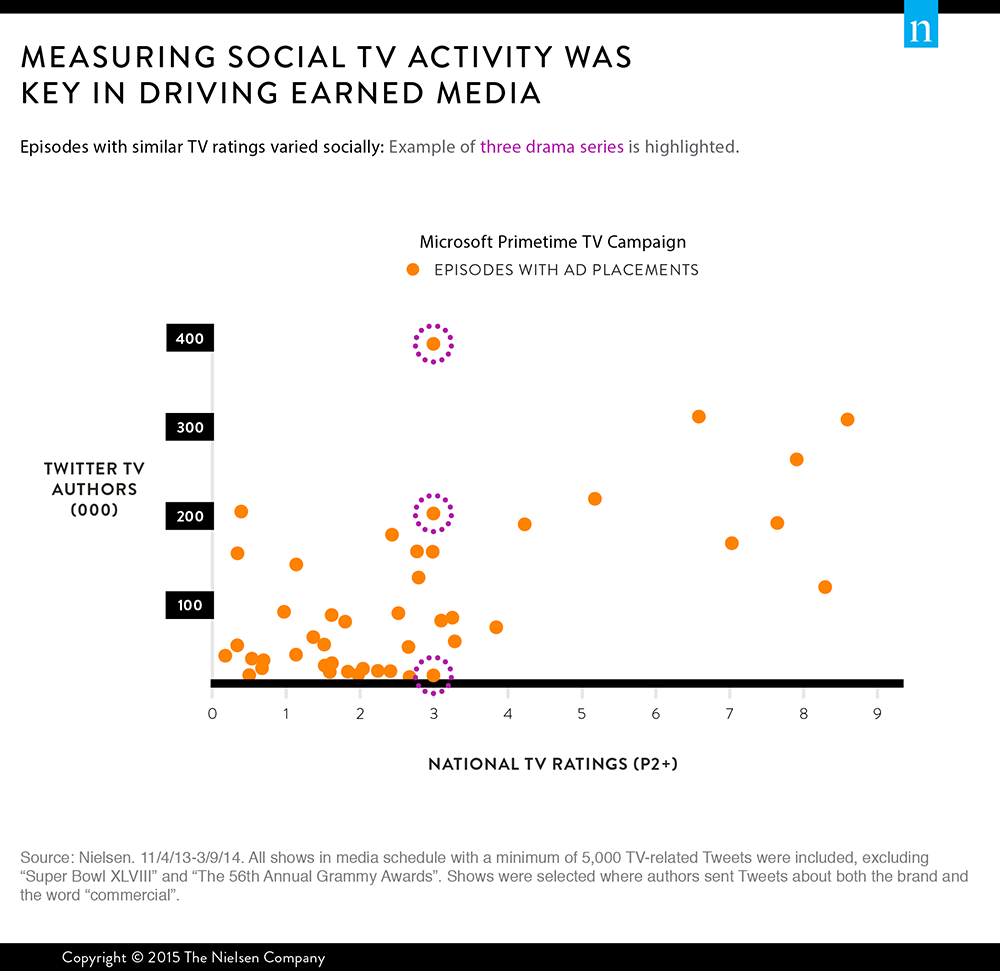In today’s connected world, where consumers can use social media to immediately share their experiences and opinions with friends and followers, a key objective for advertisers can be to turn paid media into earned media. For Microsoft, this meant optimizing its TV advertising to drive social activity around its brand. To help the company understand its audiences’ reactions, Nielsen Social analyzed Microsoft-related Twitter activity around a recent U.S. ad campaign.
The findings were dramatic.
In the 30 days after the campaign, Microsoft Tweets lifted 41% from those who sent Tweets about at least one primetime show that Microsoft ads aired within (exposed TV authors). Comparatively, conversation around Microsoft Tweets declined 38% from those who did not send any Tweets about shows the company’s ads had aired in (the control group). The implication is that exposure to Microsoft TV ads drove significant lift in earned media.

However, not all ads are created equally. Microsoft’s campaign contained two distinct types of creative: one was emotional that tugged at the heartstrings of viewers while the other was more rational with creative that focused on the product’s competitive benefits with price as a call to action.
Overall, the emotional ads drove significantly more Microsoft discussion from exposed TV authors compared to the rational ads. But program type also played a role. The sports genre and certain tent pole events were highly effective for the emotional ads, while certain programs in the comedy and drama genres drove most Twitter conversation for the rational ads.
But which specific TV placements were most effective in driving earned media for Microsoft? To determine this, Nielsen Social analyzed placements in two steps:
- Ranked each ad placement based on the volume of Microsoft-related Twitter activity from TV authors exposed to the episode in which the placement aired.
- Layered onto the ranking the amount of Twitter TV activity (authors sending program-related Tweets) and the TV viewership (National TV Ratings for P2+) for the TV episode in which each ad placement aired.
Putting the volume of Microsoft-related Twitter activity in the context of how social an episode was and how many people viewed the episode was critical to understanding what drove buzz. Nielsen Social found that ad placements in more social episodes drove nearly five times more mentions for Microsoft commercials compared to less social programs. This confirmed for Microsoft that social TV activity, as opposed to TV viewership, is the key in driving earned media.

From the study, Microsoft gleaned several key insights about how its paid TV campaign drove earned media. First, Microsoft learned that exposure to the TV campaign produced a dramatic lift in Twitter buzz compared to a control group. Second, Microsoft learned that while the emotional creative was most effective overall at driving Twitter buzz, rational ads outperformed in certain program types. Finally, Microsoft learned that ad placements in more social shows drove more Twitter buzz, underscoring the importance of factoring Twitter TV activity into TV planning in order to select shows with high social engagement and thus a greater likelihood to drive earned media.
Ultimately, the study gave Microsoft the information it needed to optimize and improve future TV media schedules and campaign creative decisions to maximize earned media. For additional insights, download the full case study.
Methodology
The Nielsen Social “cohort analysis” used in the first part of this study to determine brand lift measured the volume of Microsoft-related Tweets from two distinct groups (cohorts) during the 30-day period before and after the Microsoft TV campaign aired on a national ‘Primetime’ TV schedule. Exposed TV Authors were Microsoft authors who sent Tweets about at least one show that Microsoft ads aired in within the primetime TV schedule analyzed. Control Group Authors were Microsoft authors who did not send Tweets about any of the shows that Microsoft ads aired in within the primetime TV schedule analyzed. Some authors within the control group may have been exposed to ads without Tweeting about program content or ads placed outside of the analyzed TV schedule.



